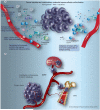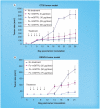Chemokines, costimulatory molecules and fusion proteins for the immunotherapy of solid tumors
- PMID: 22053884
- PMCID: PMC3226699
- DOI: 10.2217/imt.11.115
Chemokines, costimulatory molecules and fusion proteins for the immunotherapy of solid tumors
Abstract
In this article, the role of chemokines and costimulatory molecules in the immunotherapy of experimental murine solid tumors and immunotherapy used in ongoing clinical trials are presented. Chemokine networks regulate physiologic cell migration that may be disrupted to inhibit antitumor immune responses or co-opted to promote tumor growth and metastasis in cancer. Recent studies highlight the potential use of chemokines in cancer immunotherapy to improve innate and adaptive cell interactions and to recruit immune effector cells into the tumor microenvironment. Another critical component of antitumor immune responses is antigen priming and activation of effector cells. Reciprocal expression and binding of costimulatory molecules and their ligands by antigen-presenting cells and naive lymphocytes ensures robust expansion, activity and survival of tumor-specific effector cells in vivo. Immunotherapy approaches using agonist antibodies or fusion proteins of immunomodulatory molecules significantly inhibit tumor growth and boost cell-mediated immunity. To localize immune stimulation to the tumor site, a series of fusion proteins consisting of a tumor-targeting monoclonal antibody directed against tumor necrosis and chemokines or costimulatory molecules were generated and tested in tumor-bearing mice. While several of these reagents were initially shown to have therapeutic value, combination therapies with methods to delete suppressor cells had the greatest effect on tumor growth. In conclusion, a key conclusion that has emerged from these studies is that successful immunotherapy will require both advanced methods of immunostimulation and the removal of immunosuppression in the host.
Figures











References
-
- Lizée G, Cantu MA, Hwu P. Less yin, more yang: confronting the barriers to cancer immunotherapy. Clin. Cancer Res. 2007;13(18 Pt 1):5250–5255. - PubMed
-
-
Stewart TJ, Abrams SI. How tumours escape mass destruction. Oncogene. 2008;27:5894–5903. ■ Excellent primer on tumor immune escape for clinicians and basic scientists, written by an expert in the field of immunotherapy.
-
-
- Stewart TJ, Smyth MJ. Improving cancer immunotherapy by targeting tumor-induced immune suppression. Cancer Metast. Rev. 2011;30(1):125–140. - PubMed
-
-
Sadun RE, Sachsman SM, Chen X, et al. Immune signatures of murine and human cancers reveal unique mechanisms of tumor escape and new targets for cancer immunotherapy. Clin. Cancer Res. 2007;13:4016–4025. ■ Ground-breaking publication showing how identification of the major mechanisms of immune escape in colorectal and breast cancer can be used to tailor successful immunotherapy approaches.
-
-
- Goldman B, DeFrancesco L. The cancer vaccine roller coaster. Nat. Biotechnol. 2009;27(2):129–139. - PubMed
Publication types
MeSH terms
Substances
Grants and funding
LinkOut - more resources
Full Text Sources
Other Literature Sources
